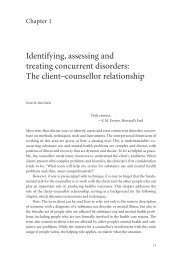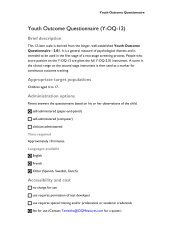Clinical Supervision Handbook - CAMH Knowledge Exchange ...
Clinical Supervision Handbook - CAMH Knowledge Exchange ...
Clinical Supervision Handbook - CAMH Knowledge Exchange ...
Create successful ePaper yourself
Turn your PDF publications into a flip-book with our unique Google optimized e-Paper software.
ecognized the limitations of his professional involvement and<br />
more clearly understood what could realistically be achieved with<br />
this couple during a brief inpatient stay.<br />
Authority and dependency issues are frequently at the root of parallel processes<br />
(Grey & Fiscalini, 1987). If the clinical supervisor and clinician don’t explore<br />
motivations for engaging in this process, they may get stuck in a series of transferencecountertransference<br />
interactions. Grey and Fiscalini (1987) state that this is avoided<br />
if the clinical supervisor empathizes with the clinician, but does not get stuck in<br />
the empathic process. The clinical supervisor is able to see the client and clinician’s<br />
perspectives, and differentiate them from his or her own. The supervisor is then able<br />
to clarify the transference-countertransference interplay occurring. However, if the<br />
clinical supervisor does get caught up in a parallel process, he or she can use his or<br />
her own emotional response to explain the anxiety in the clinician-client dyad and,<br />
additionally, the anxiety in the supervisor-clinician dyad.<br />
Exploring transference, countertransference and parallel process as they emerge<br />
within the supervisory relationship and clinician-client dyad ultimately illuminates<br />
a deeper, more meaningful understanding of the client.<br />
Conclusion<br />
Ongoing <strong>Clinical</strong> <strong>Supervision</strong><br />
Individual clinical supervision, when conducted in the context of a supportive, trusting<br />
relationship, is a vital process that contributes significantly to quality client care.<br />
As the clinician’s capacity to engage in reflective practice grows, so too does his or<br />
her ability to establish therapeutic relationships with clients. The supervisory process<br />
is a journey that clinical supervisor and clinician embark on together. It is a journey<br />
that in so many ways models the clinician-client relationship by introducing experientially<br />
concepts critical to the development of healthy and therapeutic relationships<br />
with clients such as empowerment, empathy, trust and boundaries. The supervisory<br />
process and the client are better understood through discussions of transference,<br />
countertransference and parallel process as they emerge along the way. While taking<br />
time out of one’s busy schedule to participate in or conduct clinical supervision<br />
may at times seem challenging, this is time well spent, particularly when one sees<br />
the positive outcomes for clients, the therapeutic impasses that are overcome, and<br />
the boundary transgressions that are avoided.<br />
63

















